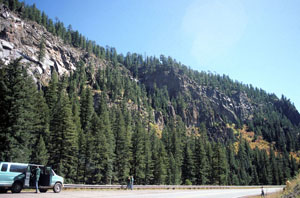Distant Connections
The hunting and gathering peoples who populated the South Texas Plains throughout prehistory left no ruins like those of the settled farmers of Mexico or the American Southwest. Most of what remains are artifacts made of stone, shell, pottery, and sometimes bone, that have survived the ravages of time. It’s easy to think of these peoples being wholly occupied with their day-to-day, hand-to-mouth existence – so focused on necessity, that they lived in “isolation,” with no knowledge of the world beyond their nearest neighbors. Archeological evidence, however, clearly shows that trade and exchange were very important to the native peoples of south Texas, beginning in Paleoindian times, and, as the above quote from Cabeza de Vaca demonstrates, well into the Historic era.
Cabeza de Vaca’s narrative of his days as a trader, during which he traveled 40-50 leagues inland, says that he brought the hunters and gatherers things that they “needed.” Yet is obviously the case that the peoples of the interior could have gotten by without the items of marine shell. Such objects must have had an importance that went beyond the daily grind of food-collecting. The peoples of the coast did need “flint for arrow points,” as de Vaca put it, because suitable stone was absent from the coastal strip. They also needed inland cane suitable for arrow shafts (and perhaps preferred bow-making wood).
The Cabeza de Vaca account shows trade processes in place which may date back thousands of years. His testimony suggests that the role of trade and exchange was handled by an itinerant merchants. This would account for the presence, in numerous sites of the South Texas Plains, of disc-shaped conch shell beads (“sea beads”), conch columella pendants, and tools made from the shell “cores” he reported, such as shell adzes or knives. Shell tools while common along the coast ,are rarely found at inland sites, with the notable exception of the Morhiss site. The movement of coastal resources inland would also account for the asphaltum sometimes found rubbed into incised bone designs, used as an adhesive to affix (haft) dart points to foreshafts, or used to patch or decorate bone-tempered pottery.
These sorts of “exotic” artifacts – marine shell and other coastal commodities—reflect a regional trade pattern that also extended into the Edwards Plateau and the Lower Pecos Canyonlands. The same could be said for the presence of Edwards Plateau cache bifaces and other stone tools made of Edwards chert deep into the South Texas Plains. One can imagine itinerant merchants operating from the Edwards Plateau down into south Texas and over into east Texas. Again, the hunters and gatherers of the South Texas Plains didn’t really “need” these things. They had flint and chalcedony, although in cobble form – but these large cache bifaces were needed to indicate status (and wealth?), and to be used in ritual and burial. Cabeza de Vaca learned of a mythical creature called Mala Cosa (“Bad Thing”) who was said to carry a very large flint knife with which he inflicted wounds on humans.
There is, however, evidence of a distinct pattern of long-distance trade in southern Texas. Occasional artifacts from Mesoamerica, and more commonly, pieces of obsidian (volcanic glass) from as far away as Idaho and central Mexico. The mechanisms that moved these artifacts into south Texas are not as easy to explain as the regional trade observed by Cabeza de Vaca and other early Spanish travelers. Long-distance trade obviously involved intermediaries at several levels, specific trade routes, and a variety of “down the line” exchange processes.
Archeologists often use the term “exchange” instead of “trade” because we don’t know if items were traded in some sort of barter system, like flint for shell for instance, or exchanged for other reasons. Especially in the case of small rare items from far away, exotic items may have passed from group to group as part of social interactions to promote good relations and cement alliances. Exotic “ritual” items may have also been part of the spread of religious beliefs. Call it trade or exchange, things somehow made their way over thousands of miles across North America long before horses made travel much faster. Cabeza de Vaca’s first-hand experience around A.D. 1530 suggests that specialized traders may well have been operating long before early historic times.
Items that reached the South Texas Plains from afar include a few artifacts from Mesoamerican civilizations (such as ceramic spindle whorls), Alibates flint from the Canadian River in the Texas Panhandle, and, most commonly, obsidian. Pieces of obsidian, a shiny and extremely sharp volcanic glass, have been found at more than a dozen south Texas sites, as well as observed in private collections. Generally, these are small flakes, arrow points, or fragments of dart points. While the numbers of obsidian artifacts are relatively small, these can be utilized to discern ancient trade routes.
Using x-ray fluorescence or neutron activation analysis, most obsidian can be chemically distinguished (“fingerprinted” by rare trace minerals at the level of parts-per-million) and linked back to its original geological source or outcrop. Any piece of obsidian in found in archeological contexts in Texas comes from beyond the state's borders, as no source of artifact-quality obsidian occurs in the state. Geologists have recorded occurrences of very poor quality perlites and rhyolites in western Texas, but samples from these outcrops have been found to have chemical characteristics unlike any obsidian archeological specimens in the state.
Much of what we now know about the sources of obsidian artifacts found in Texas has been learned by the Texas Obsidian Project (TOP). This project began in 1970 as a modest effort to link four obsidian artifacts from Dimmit County in south Texas to their geological sources. Prompted by an archeological graduate student at the University of California, Berkeley (author Tom Hester), a Berkeley geologist, Robert Jack, who specialized in x-ray fluorescence (XRF) analysis of obsidian and other materials, agreed to analyze the Dimmit County specimens as part of his ongoing research. TOP expanded from there. In the early l970s, with the aid of several Texas avocational archeologists, and especially with the help of Dee Ann Story, who then directed the Texas Archeological Research Laboratory at the University of Texas at Austin. We were able to secure additional obsidian artifacts from various localities in Texas.
The project expanded greatly in the late l970s, when a collaborative study was begun with Drs. Frank Asaro and Fred Stross, at the Lawrence Berkeley National Laboratory, University of California, Berkeley. Asaro and Stross were pioneers in the area of obsidian trace element studies. In the study of Texas obsidians, they have used both XRF (non-destructive) and neutron activation analysis (NAA; which requires the destruction of a piece of the artifact). We secured many more specimens from throughout Texas, with help from a number of people – both professionals and avocationals—including more specimens from sites on the South Texas Plains.
Our TOP project was one of a number of obsidian sourcing projects in the Southwest and western United States. With the use of trace element analysis, archeologists have been able to identify hundreds of obsidian sources, and there is now a vast literature on obsidian sources and trade routes in California, the Southwest, and the Great Plains. These studies have pointed to, for example, very early trade routes. Obsidian of Clovis age came from central Mexico and wound up at the Kincaid Shelter on the northern edge of the South Texas Plains. And, while a number of Texas obsidian artifacts are of Archaic age, much of the obsidian trade was considerably later. Around A.D. 1400, specialized traders operated out of trade centers like Pecos Pueblo in the Southwest. But, there were also traders operating in hunting and gathering cultures on the Plains. Obsidian from Yellowstone, Wyoming (Obsidian Cliff) and Malad, Idaho, were moved via a north-south Plains trade network that extended well into southern Texas.
The obsidian sample from the South Texas Plain now totals 15-20 artifacts. But, there are another dozen obsidian artifacts from the lower Rio Grande valley near the coast. The Brownsville Complex of that area is particularly noted for the presence of a number of obsidian artifacts, as well as artifacts made from Mexican jadeite, and pottery vessels made in the Huasteca area. We used to think that this was essentially a Late Prehistoric trade relationship between the hunters and gatherers of the Rio Grande Delta and the Late Postclassic Huastec-related cultures 200 miles down the Mexico coast (and with outposts in the mountain ranges such as the Sierra de Tamaulipas).
But, recent studies by Dr. Tiffany Terneny have demonstrated that such trade started much earlier, in the Late Archaic – well before Huastecan culture was established. We have no solid evidence of what the Mexican traders wanted…perhaps salt from the beds of Delta lakes, shell artifacts, or dried fish of some sort. We have no idea why the Delta hunters and gatherers wanted flakes of obsidian, artifacts of poor quality green jadeite, and in late times, large pottery vessels. Much of this material, though not all of it, shows up with burials, and so the “need” may well have transcended any daily necessities of life. It will take much more work at the mouth of the Rio Grande and on the Gulf Coast and coastal plains of Mexico to better delineate the kinds of exchange that were involved.
North of the Rio Grande Delta on the South Texas Plains and along the coast, obsidian flakes, points, and bifaces have been found in several counties. Most are surface finds and rarely can be dated with any precision. A heavily-beach rolled Clovis point from Lavaca Bay is among the earliest obsidian artifacts. Its source is not yet among those that have been identified, although a piece of obsidian from the same unknown source was found in Early Archaic contexts at site 41NU221 near Corpus Christi. Archaic-style dart point fragments of obsidian are also known, one from southern Uvalde County (Otumba source) and another from Atascosa County (source unknown). A point with its stem missing is recorded from Dimmit County, made of Malad (Idaho) obsidian. In the same area, two elongate bifaces are sourced to Mexico (the poorly known Santa Teresa source in the state of Jalisco). Many of the other obsidian artifacts, some which cannot be dated, derive from the Malad source, including two Late Prehistoric corner-notched arrow points found at a site in McMullen County. Two tiny arrow points found at the same site have been sourced to southern New Mexico, suggesting that obsidian from different sources may have been traded together.
Overall, the obsidian of the South Texas Plains came from very distant sources, ranging from central Mexico to southeastern Idaho. The Malad source is located in southeastern Idaho, and obsidian from that source is found from Kansas and Oklahoma into the Choke Canyon Reservoir of south Texas (site 41LK51). Two important New Mexico sources are Cerro del Medio and Cerro Toledo (sometimes referred to as "Valles Caldera" or Obsidian Ridge;) in the Valles and Toledo volcanic calderas of the Jemez Mountains north of Santa Fe, New Mexico.
Then, there are the several sources from deep in Mexico. In the Rio Grande Valley, obsidian is identified from the sources at Cerro de las Navajas (Pachuca, Hidalgo), Ojos Zarcos (Queretaro), and especially Zacualtipan, Hidalgo, a source well known for its exploitation by the Huastecs.
Up the Rio Grande and into the South Texas Plains, obsidian from the Otumba source is found (Zapata and southern Uvalde Counties), the Cerro de Las Navajas source (Starr County), and Santa Teresa, Jalisco, in western Mexico (Dimmit County; and though outside the area, from a rockshelter in Terrell County, west Texas).
There are also obsidian specimens for which we cannot yet determine the geologic source. Their trace element patterns do not match any of the sources identified in Mexico or western North America. These include the Clovis point from Lavaca Bay, a dart point distal fragment from Atascosa County, and a large biface from Webb County.
With so few identified obsidian artifacts from the South Texas Plains, it is difficult to point to possible trade routes. The Delta- Huasteca connection has already been noted. Malad (Idaho) obsidian occurs very commonly on the Edwards Plateau, clustering along its eastern edge. This probably represents a north-south trade route of the sort proposed by Tim Baugh and Fred Nelson for Late Prehistoric Malad obsidian (A.D. 1100-1400), a trading pattern that persisted into Historic times.
What we can say for sure is that obsidian sourcing has proved that the prehistoric inhabitants of the South Texas Plains did have distant connections with peoples and places thousands of miles away. And ideas and information must have passed far more easily and quickly than physical things. Early historic accounts of native peoples on the South Texas Plains show that knowledge of far-away groups and of distant events spread much farther and faster than we might imagine.
Contributed by Dr. Thomas R. Hester.
Sources
Baugh, T. G. and F. W. Nelson, Jr.
1987 New Mexico Obsidian Sources and Exchange on the Southern Plains. Journal of Field Archaeology 14(3): 313-329.
Giauque, R. D., F. Asaro, F. H. Stross and T. R. Hester
1993 High-Precision Non-Destructive X-Ray Fluorescence Method Applicable to Establishing the Provenance
of Obsidian Artifacts. X-Ray Spectrometry 22:44-53.
Hester, T. R.
1986 The Texas-Idaho Obsidian Connection. La Tierra 13(2): 2-5. 1995 The Prehistory of South Texas.
Bulletin of the Texas Archeological Society 66:427-460.
1999 Artifacts, Archaeology and Cabeza de Vaca. Bulletin of the Texas Archeological Society 70:17-28.
Hester, T. R., J. W. House, R. N. Jack and F. H. Stross
1975 X-Ray Fluorescence of Obsidian Artifacts from the Rio Grande Plain, Southern Texas. Texas Journal
of Science 26(1-2):286-289.
Hester, T. R., J. L. Mitchell, F. Asaro and F. Stross
1980 Further Notes on Obsidian Artifacts
from Dimmit County, Southern Texas. La Tierra 7(3):30-33.
Lonsdale, J. T. and R. A. Maxwell
1967 Geology of Intrusive Igneous Rocks. In Geology of Big Bend National Park, Brewster County, Texas,
by R. A. Maxwell, J. T. Lonsdale, R. T. Hazzard, and J. A. Wilson, pp. 170-270. The University of Texas
Publication 6711. Bureau of Economic Geology, The University of Texas at Austin.
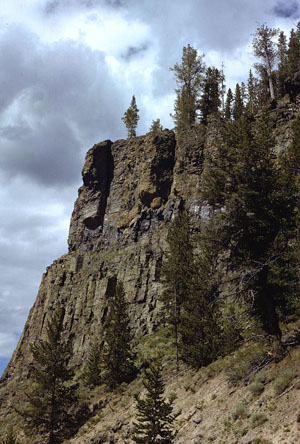
Obsidian Cliff in Wyoming. Obsidian
from this well-known source were widely traded in western North America and occasionally made it as
far south as southern Texas. Photo courtesy T.R. Hester.
|
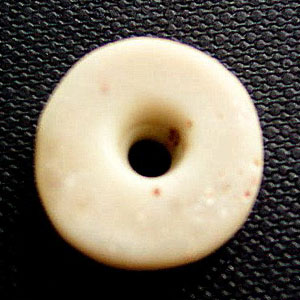
Conch shell disk bead, Zavala County,
Turlington Collection. Marine shells and shell artifacts from the Texas coast were commonly traded
inland and have been found in many sites across the South Texas Plains.
|

Conch pendant from Sabinal River
drainage, Uvalde County. Photo by T. R. Hester
|
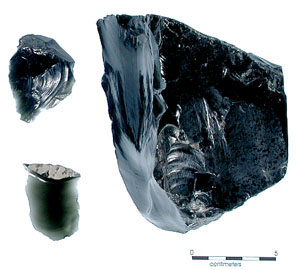
Obsidian is a shiny and extremely sharp volcanic glass. These specimens are
modern material samples from several sources. Photo by Milton Bell.
|
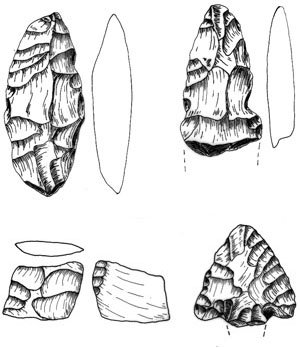
These four obsidian artifacts from
archeological sites in Dimmit County were the first samples analyzed by what became the Texas
Obsidian Project. Drawings by Pamela Headrick
|
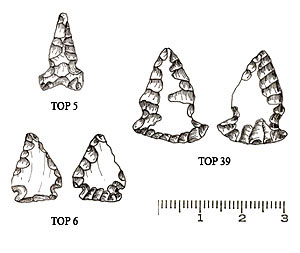
Obsidian arrow points from sites in
McMullen and Medina County. The Medina County specimen has been traced to the Malad source in Idaho.
Drawings by Pamela Headrick
|
